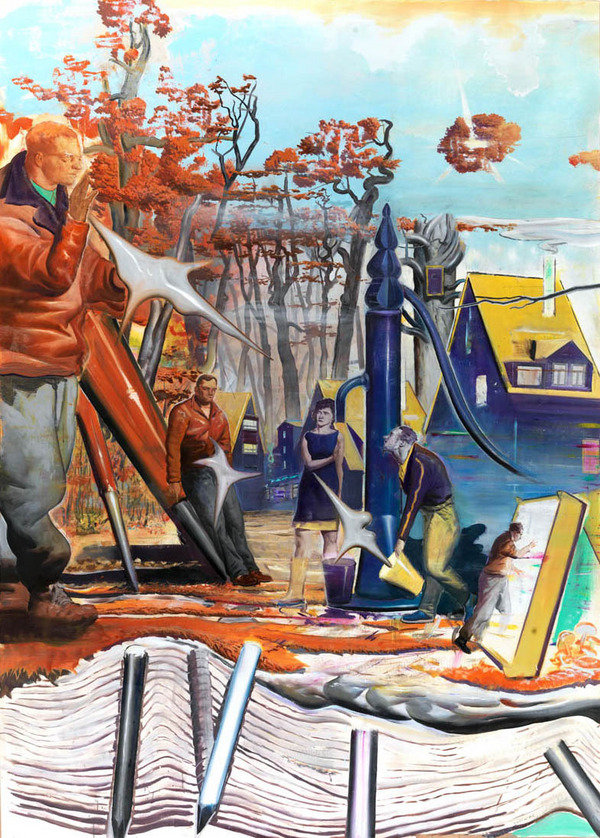Gegenlicht
dal 24/5/2013 al 18/1/2014
Segnalato da
Georg Baselitz
Otto Dix
Conrad Felixmuller
Walter Gramatte'
George Grosz
Erich Heckel
Anselm Kiefer
Ernst Kirchner
August Macke
Max Pechstein
Neo Rauch
Christian Schad
Rudolf Schlichter
24/5/2013
Gegenlicht
State Hermitage Museum, St. Petersburg
The Greek art collector George Economou has over the last 2 decades assembled an important collection of Modern and Postwar art. The core of the exhibition is shaped by German art from the interwar period, at a time when Weimar intellectuals embraced a sobering social return to quotidian.

Georg Baselitz, Otto Dix, Conrad Felixmüller, Walter Gramatté, George Grosz, Erich Heckel, Anselm Kiefer, Ernst Kirchner, August Macke, Max Pechstein, Neo Rauch, Christian Schad, Rudolf Schlichter
The State Hermitage Museum is delighted to announce the exhibition Gegenlicht. German Art from
the George Economou Collection. Exploring the legacy of German Expressionism and New
Objectivity on Postwar and Contemporary art, the exhibition installed in the new Contemporary
wing, brings together major works from the last one hundred years of German art from the
collection. We are honoured to appropriate Gegenlicht (counterlight) from the poetry of Paul Celan,
who was deeply linked to German history of the Postwar period.
The Greek art collector George Economou has over the last two decades assembled an important
collection of Modern and Postwar art. The core of the collection is shaped by German art from the
interwar period, at a time when Weimar intellectuals embraced a sobering social return to quotidian.
Following World War I, there was a collective detachment from emotion and a sharp shift toward the
objective world. Leading artists such as Otto Dix, Christian Schad and George Grosz, reacted with
realist humanistic depictions, and in turn, founded the New Objectivity movement. Affected by the
shocking brutality of the First World War, the prominent misery, poverty and starvation, the artistic
sensibility found new remarkable ways of expression and intensity in an emotional subject. The
collection follows through pre-World War I developments of the foremost German Expressionists,
Ernst Ludwig Kirchner, Max Pechstein and Erich Heckel, who boldly initiated their emotive reaction
to the advancing, modern world stylistically and within their subjects. Once National Socialists seized
power in early 1933, New Objectivity and Expressionism was deemed a “degenerate art” by the
newly reigning authorities and suffered destruction and symbolic desecration. After World War II,
these transformative artists were not only internationally acknowledged for their critical statements,
but also widely recognized as very influential to the contemporary art scene.
New interpretations of Expressionism flourished in the late 1970s and 80s as a reaction to
minimalism and conceptual art. The powerful wave of Neo-Expressionism inspired half of the globe;
United States, Great Britain, France, Italy, Spain, South Africa. The legacy of New Objectivity as well
as German Expressionism became crucial for young artists, particularly in Germany. The “Neue
Wilden” such as Georg Baselitz, Anselm Kiefer, Jörg Immendorff and Markus Lüpertz returned to an
emotionally driven manner of creativity based on figurative imagery and intense colorism. Baselitz’
key work of this period, Adler im Bett (1982) will be on display at the Hermitage as well as the late
major work Tempelhof by Kiefer. Furthermore, the exhibition juxtaposes master drawings of
German Expressionism to works of Baselitz to show their influence on the “Neue Wilde”. To
represent the next distinguished generation of figurative German painters, Neo Rauch will be
exhibited to anchor the central importance of German art in the twentieth and twenty-first centuries.
The exhibition is accompanied by an illustrated catalogue in Russian and English that includes the
foreword by Prof. Dr. Mikhail Piotrovsky and contributing essays by Hermitage curator Dimitri
Ozerkov and art historian Dieter Buchhart.
The show is organized by The State Hermitage Museum in collaboration with The George Economou
Collection in the framework of 'Hermitage 20/21 Project for contemporary art'. Created in 2007
by Dr. Prof. Mikhail Piotrovsky, general director of the State Hermitage Museum, it is an initiative to
show and collect modern and contemporary art. Gegenlicht. German Art from the George
Economou Collection is the first project in 'Classical Modernism', the new series of exhibitions
organized by Hermitage 20/21.
George Economou was born in Athens, Greece and is a graduate of the Massachusetts Institute of
Technology (MIT). He began his career in shipping, expanded in offshore drilling and real estate, and
has shared a passion for art throughout his career. His collecting activity began evolving in the 1990s
with a focus on early twentieth-century European art and has grown to include an important holding
of postwar and contemporary art. In 2012 he opened an exhibition space for the collection in the
suburbs of Athens, Greece where he organizes several exhibitions per year and collaborates
regularly with international institutions and curators. Also, Mr. Economou is a member of the Tate
Foundation Board of Trustees.
Image: Neo Rauch, Waldsiedlung, 2004, oil on paper 277 x 197 cm
International press:
Annie-Claire Geisinger at the George Economou Collection T +30 2108090595 / M +30 6947404053 acgeisinger@economoucollection.com
Local press:
Danil Olsen at Republico M +7 911 7491881 olsen@republico.ru
The State Hermitage Museum
General Staff building Dvortsovaya 6-8 St. Petersburg, Russia
Hours:
Tuesday - Saturday 10:30-18h
Sunday 10:30 - 17h



